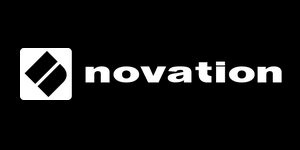
Novation or Novation Electronic Music Systems was founded in 1992 by British developers. Engineers Ian Jannaway and Mark Thompson were the co-founders of the company. Jannaway used to work at Cheetah where he was into developing and creating a 6-voice analog multitimbral rackmount MS6 synthesizer. Novation brand is a part of the The Focusrite Group – the audio interface, music soft and hardware maker.
Novation has been drawing attention of all the musicians for many years supplying them with the synthesizers of high quality. The brand is focused on controllers development featuring lots of switches, knobs, sliders. In the 2000s the new feature appeared on the soft market – Automap for your DAW which allowed you to simplify the integration of the software parameters with the hardware controllers.
The first Novation product was a portable battery powered synthesizer with full size keys MM10. The synth was aimed at interaction with Yamaha QY10 workstation. The co-work of the two devices was possible thanks to the new technology Novation MidiCon which was the first hardware controller made by the brand.
Bass Station series synthesizers was released in 1993. The first model of the series, Bass Station portable synthesizer, was able to be integrated with Roland TB-303 Bass Line providing accompaniment. The monophonic synthesizer included two DCOs, ADSR envelope generator, memory for 60 patches and classic filters which allowed you to achieve that quality analog sound reminding of Moog (Micromoog) and Sequential Circuits Pro One. Rackmount version of the synthesizer came out in 1994 and became a market hit straight away. The new and great thing to do was to introduce the MIDI/ CV converter to control Bass Station via external instruments. The model of the 1997, Super Bass Station, comprised arpeggiator, double memory, ring modulation, two oscillators + one sub which let you create up to 300 realistic patterns.
The new upgraded version called Bass Station II (2013) included USB and MIDI implementation, three oscillators, two filters for creating analog effects of high quality, step sequencer, velocity sensitive keyboard with aftertouch. The operation was also simplified making it easier to control the instrument – the interface was extended and elaborated and more control elements were added.
The second series which brought fame to Novation was the series of polyphonic analog modeling synthesizers Supernova (1998) – it numbered two versions: Supernova and Supernova II (both rackmount and keyboard variants); there was also Nova module/tone-generator produced. Supernova synthesizer featured a 20-voice polyphony with the expansion possibility up to 32 voices. The powerful effect processor determined the ability to apply up to 7 effects simultaneously without any polyphony loss! Supernova also had quite a rare feature - 3-pole filter (18dB) plus to the traditional 12dB and 24dB ones. All the filters are resonant, self-oscillating and feature overdrive.
The improved Supernova II offered from 24 to 48 voices of polyphony. The velocity sensitive keyboard was filled with aftertouch technology. The model included arpeggiator, FM synthesis, ring modulation and vocoder function. The effect processor allowed Supernova II to produce a truly rich sound of high quality which was approved by many professional musicians. Novation launched 12- and 24-voice expansion modules for Supernova and Supernova II. Today Novation Supernova is considered to be a living legend of the music world and one of the favorite instruments of collectors and profiteers.
Ultranova synthesizer took Supernova II’s synth engine but improved the efficiency and altered the functionality. The instrument offered 18 voices of polyphony, 14 filters, USB interface, 37 full size velocity sensitive keys with aftertouch, vocoder function.
Novation X-Station series (2004), as rebranded K and KS series, became a bright representative of Novation MIDI controllers. X-Station made it possible to update operating system via USB unlike its predecessors. The model uses the new synthesis method Liquid Analogue Sound which brings it closer to the capabilities of Supernova.
Remote SL series released in 2005 introduced the new soft brought to the market by Novation – Automap which allowed us to control settings and parameters of the instrument automatically in real time. Automap was also introduced in such brand series as Nocturn, Launchpad, Impulse.
Mininova, launched in 2012, appeared to be another successful microsynth series. Ultranova’s synth engine together with step sequencer, 37 mini keys let the instrument extend its possibilities up to groove synth level or even a stage keyboard. Mininova offers 3 oscillators per voice, 2 filters, 3 LFOs upload a wide range of sounds onto sequencer tracks. There’s also USB and MIDI support. Small dimensions of the synthesizer, simple intuitive control helps musicians get inspired and create freely anywhere they are. Mininova comprised a VocalTune function which transforms a user’s voice processing it through the synth tone played back at the moment.
Mininova was especially good for DJs and electronic musicians but Novation’s rivals weren’t sleeping their profit away they went on producing similar devices. In 2016 Novation released sound library update as a limited MoroderNova series in order to bring the market attention back. Name rings a bell for sure and quite loud and you’ll definitely want to listen to those patches.
Right now Novation possesses a global client database but the company’s still interested in promoting its affordable and multifunctional products which is appraised by both amateurs and professionals.










